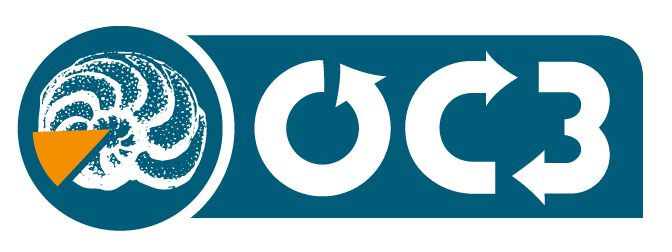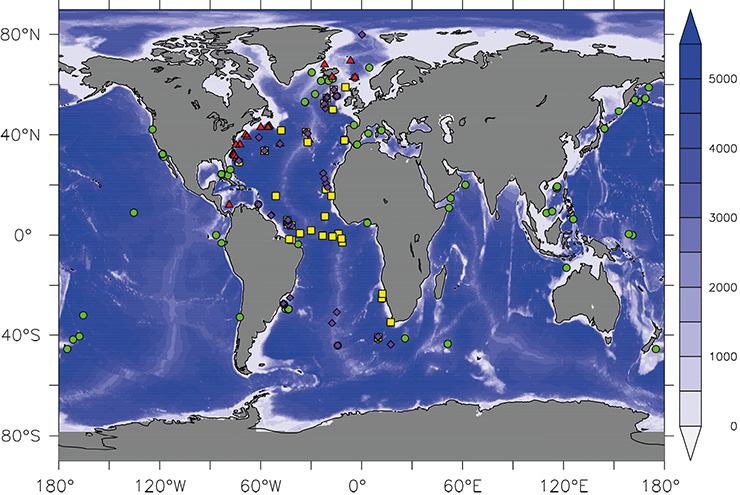- Home
- Publications
- PAGES Magazine
- Ocean Circulation and Carbon Cycling During The Last Deglaciation: Global Synthesis
Ocean circulation and carbon cycling during the last deglaciation: global synthesis
Repschläger J, Schmittner A, Lippold J, Skinner L & Muglia J
Past Global Changes Magazine
26(2)
93
2018
Janne Repschläger1, A. Schmittner2, J. Lippold3, L. Skinner4 and J. Muglia2
IPODS-OC3 workshop, Cambridge, UK, 6-9 September 2018
The transition of Earth’s climate from the cold Last Glacial Maximum (LGM) to the warm Holocene is still not fully understood. It is associated with a rise in atmospheric CO2 acting as an important driver of the global warming. Although changing ocean circulation during the deglaciation has been linked to the rates of CO2 increase, its exact mechanism remains unclear, and quantifying changes in the ocean circulation and carbon storage remain challenging tasks.
The overarching goal of PAGES’ working group Ocean Circulation and Carbon Cycling (OC3) is to compile global foraminiferal carbon (δ13C) and oxygen (δ18O) isotope data and compare them with model simulations to better understand changes in ocean circulation and carbon cycling during the last deglaciation. INQUA’s Investigating Past Ocean Dynamics (IPODS) focus group works towards the same scientific objective by synthesizing complementary global ocean circulation proxy data such as radiocarbon (Δ14C), εNd and Pa/Th. This joint IPODS-OC3 workshop aimed to make progress through new regional and global data syntheses and their combination with isotope-enabled model simulations.
The workshop brought together 40 international scientists – sea-going paleoceanographers and modelers – to report the progress within the working groups, to discuss potential overlaps between the communities and to identify potential joint aims.
On the first day of activities, OC3 regional syntheses group leaders gave updates of current activities and work progress from different ocean basins (North and South Atlantic, and Indian Ocean). Additionally, posters were presented on regional datasets and modeling approaches. δ13C and δ18O data were discussed with respect to the importance of deep and intermediate water distribution and circulation, and importance of the different ocean regions for CO2 storage and deglacial CO2 release.
The focus of the discussion was on new age-model and data-visualization software tools, including age-model approaches PARIS (Claire Waelbroeck), HMM-Match (Lorraine Lisiecki) and the age-model software and visualization tool PaleoDataView (Stefan Mulitza). Discussions included the differences of the approaches, age-model error assessments and uncertainties in reservoir age corrections.
Age models are an important backbone of OC3 and IPODs databases. As nearly all cores in the IPODS database are also included in the OC3 database (Fig. 1), the same age models will be used for the global synthesis to enable the direct comparison of different proxy records from the same cores.
The second day of the conference was designated to the IPODS working group. General summaries of the current knowledge in εNd, Pa/Th and ∆14C were given by work-group leaders, followed by presentations of recent compilation studies (Pietrowski, Blaser; Ng et al. 2018).
The final day of the workshop was dedicated to future plans of OC3 and IPODS. The participants encouraged OC3 to proceed with the database effort and developed a strategy for the refinement of the data synthesis, including the development of quality-check guidelines and consistent age-model generation. Extensive labor is needed to generate consistent age models and to ensure data quality. A detailed work plan for the next year includes the release of the final database structure with already published regional synthesis datasets, publishing of the Atlantic Ocean synthesis in the beginning of 2019, and work on syntheses papers in the summer of 2019. The chair of OC3 was passed from Andreas Schmittner to Janne Repschläger. Juan Muglia will join the steering committee in the function of database manager.
The workshop added momentum to IPODS and OC3 activities such as the writing of an εNd review paper, the creation of a joint database including δ13C, δ18O, εNd, Pa/Th and ∆14C, and the exploration of common plans for the future.
affiliations
1Max-Planck Institute for Chemistry, Climate Geochemistry, Mainz, Germany
2College of Earth, Ocean, and Atmospheric Sciences, Oregon State University, Corvallis, USA
3Institute of Earth Sciences, Heidelberg University, Germany
4Department of Earth Sciences, University of Cambridge, UK
contact
Janne Repschläger: J.Repschlaeger mpic.de
mpic.de
references

